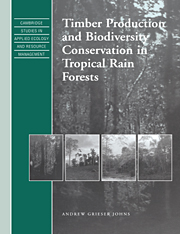Book contents
- Frontmatter
- Contents
- Foreword
- Preface
- Explanatory note
- 1 The issues
- 2 The history and development of tropical forestry
- 3 Changes in the physical environment
- 4 Forest regeneration and gap dynamics
- 5 Responses of individual animal species
- 6 Responses of species assemblages
- 7 Using ecological data in forest management planning
- 8 Intervention to maintain biodiversity
- 9 Field procedures
- 10 The future
- References
- Subject index
6 - Responses of species assemblages
Published online by Cambridge University Press: 04 December 2009
- Frontmatter
- Contents
- Foreword
- Preface
- Explanatory note
- 1 The issues
- 2 The history and development of tropical forestry
- 3 Changes in the physical environment
- 4 Forest regeneration and gap dynamics
- 5 Responses of individual animal species
- 6 Responses of species assemblages
- 7 Using ecological data in forest management planning
- 8 Intervention to maintain biodiversity
- 9 Field procedures
- 10 The future
- References
- Subject index
Summary
Introduction
Studies of the ecology of individual species can help to identify changes in feeding, ranging or other behaviour following logging, and how this may affect their population densities in logged forest. This may be important information for devising conservation strategies directed towards individual species (e.g. orang-utans in Sabah: Payne 1988). However, it is not possible to generalize from a study of a single species to management of biodiversity in a wider context. For management of biodiversity resources as a whole it is more appropriate to examine species assemblages with a view to obtaining more wide-ranging information that can be incorporated into management planning.
The extent of change within species assemblages will vary in broad terms according to the levels of disturbance. Thus a group of central African species subjected to very light levels of logging is likely to change less than an equivalent group of South-East Asian species subjected to very high logging intensities. However, there are also geographical differences in the structure of rain forest communities (Karr 1980, 1990; Bourliere 1989), reflecting different regional evolutionary processes. These differences can influence the extent of immediate change and the time taken for the community to return to its pre-logging state. For example, island forests within the cyclone belts of the Philippines and Melanesia are naturally adapted to recover quickly from extremely high levels of damage. Although the need for intervention to improve biodiversity conservation is likely to be less urgent under conditions of light logging, there is no linear relationship between logging intensity and the extent of change in species assemblages.
There are three approaches to studies of species assemblages.
- Type
- Chapter
- Information
- Publisher: Cambridge University PressPrint publication year: 1997



